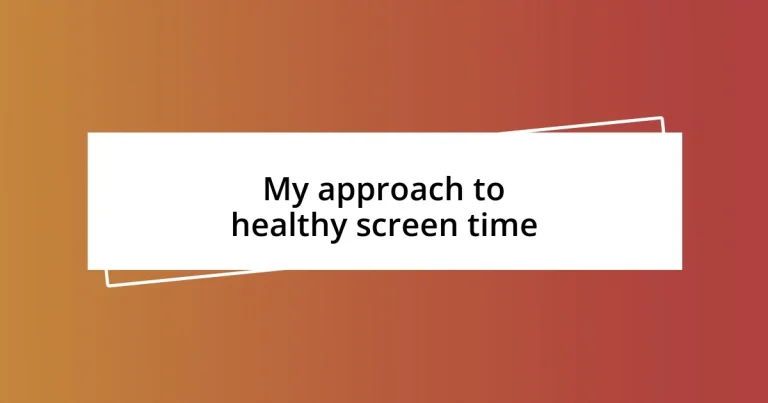Key takeaways:
- Healthy screen time is about balance; setting limits and prioritizing real-world connections can enhance well-being and productivity.
- Managing screen time leads to improved mental health, better relationships, and increased focus, allowing for a more fulfilling lifestyle.
- Engaging in screen-free activities, such as reading, nature walks, and cooking, can rejuvenate creativity and overall happiness.
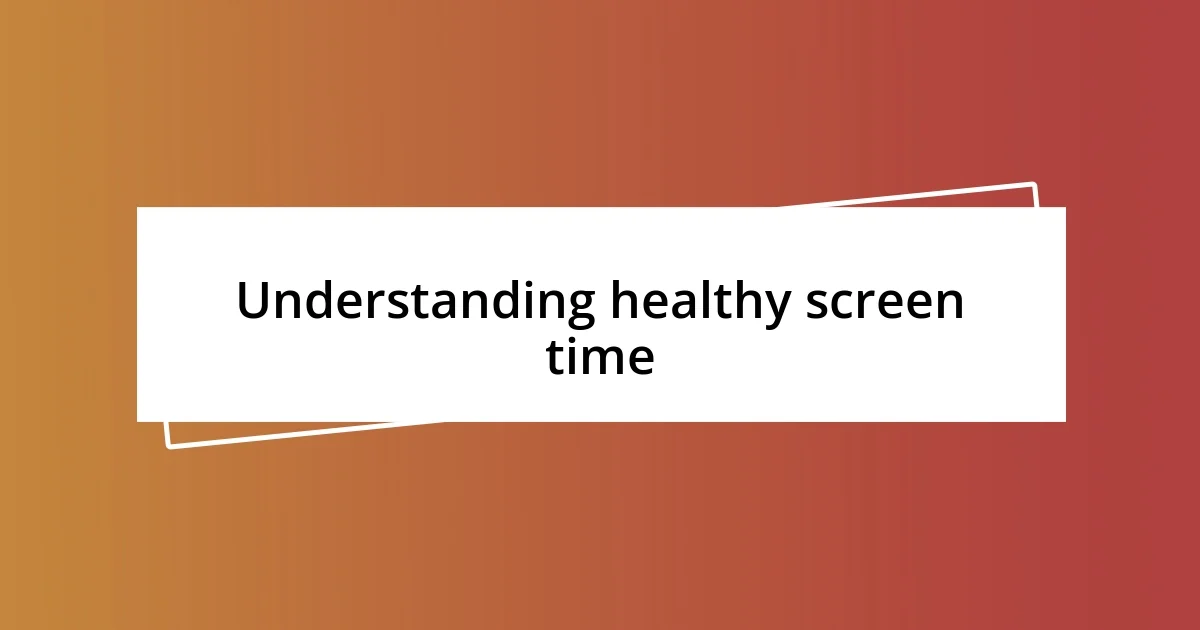
Understanding healthy screen time
When I think about healthy screen time, I often recall the days when I would get lost in endless scrolling, feeling more drained than fulfilled. It’s crucial to recognize that screen time isn’t inherently bad; what truly matters is how we engage with it. Are the activities enriching our lives or simply consuming our precious energy?
I’ve experimented with setting boundaries for my screen use, and I can attest to the difference it makes. For example, when I decided to limit social media to just 30 minutes a day, I found myself more present in my daily life. It’s fascinating how prioritizing real-world connections over digital ones can significantly boost our overall well-being.
Have you ever tried to intentionally incorporate breaks into your screen routine? I began scheduling short, tech-free moments between tasks, and I’ve noticed an improvement in my focus and productivity. It’s an eye-opener to understand that healthy screen time is all about balance; it invites us to reclaim our time and energy for the things that truly matter.
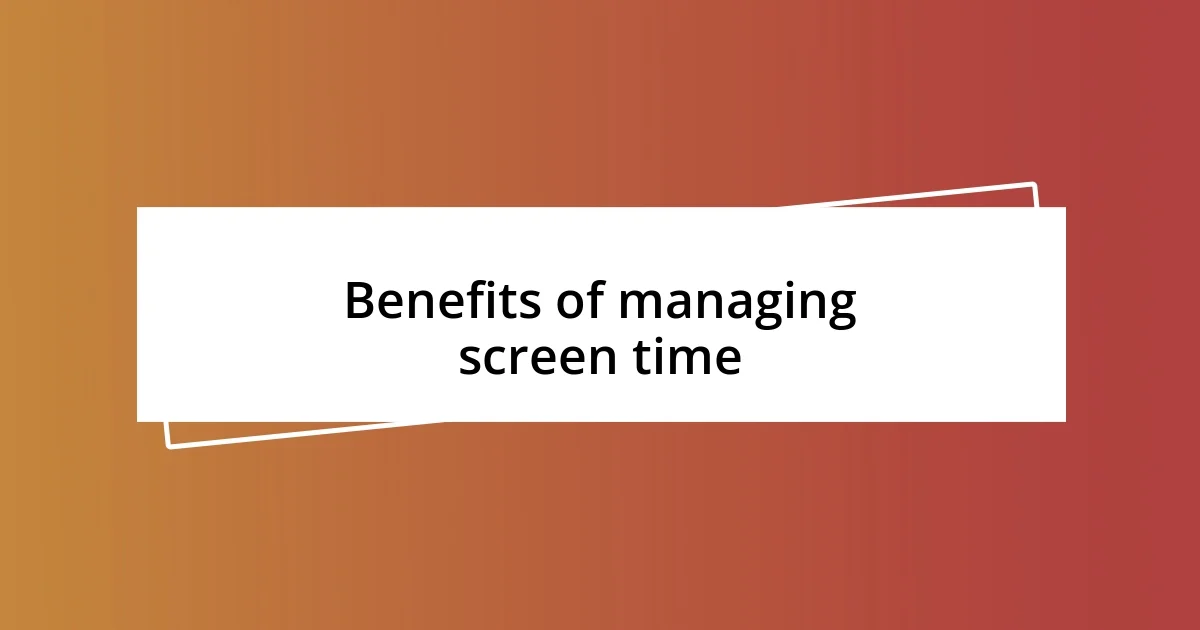
Benefits of managing screen time
Managing screen time offers a plethora of benefits that often go unnoticed until we take a step back and reflect. I remember the moment I realized my mood drastically improved on days when I consciously limited my screen exposure. Instead of feeling overwhelmed by a barrage of notifications, my mind felt clearer and my attention was sharper, allowing me to engage more fully with the world around me.
Here are some key advantages of managing screen time:
- Improved Mental Health: Less screen usage can lead to reduced anxiety and stress levels. I’ve noticed that unplugging for a while helps me recharge emotionally.
- Enhanced Relationships: By dedicating time to face-to-face interactions, I’ve strengthened my connections with family and friends, creating deeper bonds and memorable moments.
- Better Sleep Quality: Reducing evening screen time has significantly improved my sleep patterns. I’ve found that a good night’s rest enhances my mood and boosts my energy for the next day.
- Increased Focus and Productivity: Setting boundaries around my screen time has allowed me to concentrate better on tasks, ultimately making me feel more accomplished.
- Greater Physical Activity: With less time spent glued to screens, I’ve been able to embrace outdoor activities and exercise, leading to a healthier lifestyle overall.
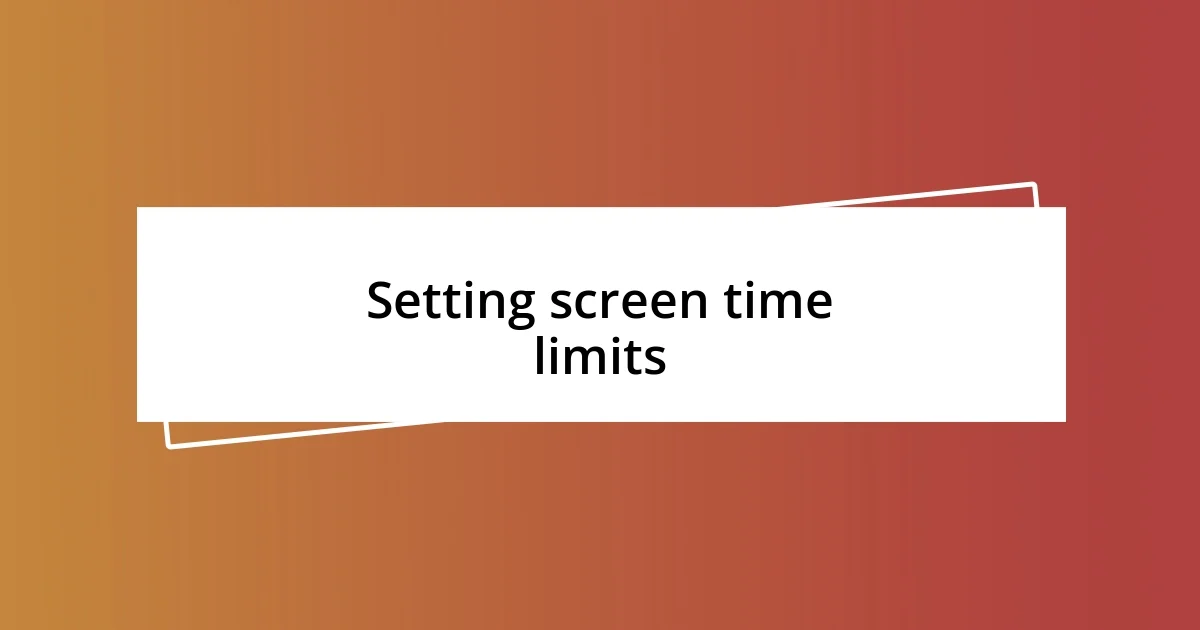
Setting screen time limits
Setting screen time limits is something I’ve become quite passionate about through my own experiences. I remember one particularly hectic week when work had me glued to my laptop for hours. By the end, I felt mentally exhausted and hardly engaged with my surroundings. That pushed me to establish clear boundaries: I now limit my screen use to specific hours. This simple act has not only diminished my fatigue but has also helped me set a consistent routine that includes more offline activities I enjoy.
I found it helpful to use apps that track my screen time, allowing me to visualize my usage. Seeing the numbers made me realize how often I mindlessly clicked on my phone. It’s eye-opening to notice how just 15 minutes less per day adds up over a week, creating time for hobbies and socializing in the real world. I even started a friendly challenge with a few friends to lower our daily screen times together, which motivated me to stick to my limits.
To me, the idea of setting limits isn’t about restriction but rather about enhancement. When I consciously choose when and how to engage with screens, I can genuinely relish my offline moments. I encourage you to experiment with limits that suit your lifestyle—maybe start with cutting out screens 30 minutes before bed and see how your sleep improves. The benefits of intentional screen time can truly transform your daily experience.
| Approach | Description |
|---|---|
| Track Usage | Use apps to monitor and visualize screen time for better awareness. |
| Limit Hours | Set specific hours for screen use to create a balanced routine. |
| Challenge Friends | Engage friends in challenges to lower screen time together for motivation. |

Choosing quality content
Choosing quality content is crucial for making the most of my screen time. I often find myself evaluating what I consume, asking, “Is this really adding value to my day?” It’s so easy to get lost in endless scrolling or binge-watching shows that don’t resonate with me. When I deliberately seek out content that inspires or educates, I not only enhance my understanding but also uplift my mood. Honestly, there’s nothing quite like finishing a meaningful documentary and feeling like I’ve expanded my perspective.
I’ve also discovered that curating my digital environment can lead to a more enriching experience. For instance, I started following creators whose work aligns with my interests, whether it’s cooking, personal development, or mindfulness. I remember the first time I stumbled upon a series of TED Talks—each one left me in awe. I felt energized and motivated after watching them! That experience transformed how I approach content. Now, I look for materials that spark my curiosity and provoke thoughtful discussions rather than just mindless consumption.
Engaging with quality content isn’t just about what we watch or read; it’s also about how we interact with it. I often take notes or share my thoughts with friends after consuming something impactful. This practice deepens my understanding and makes the experience more rewarding. How do you feel after you engage with a piece of content? If it doesn’t inspire or educate, maybe it’s time to reassess what you’re choosing to consume.
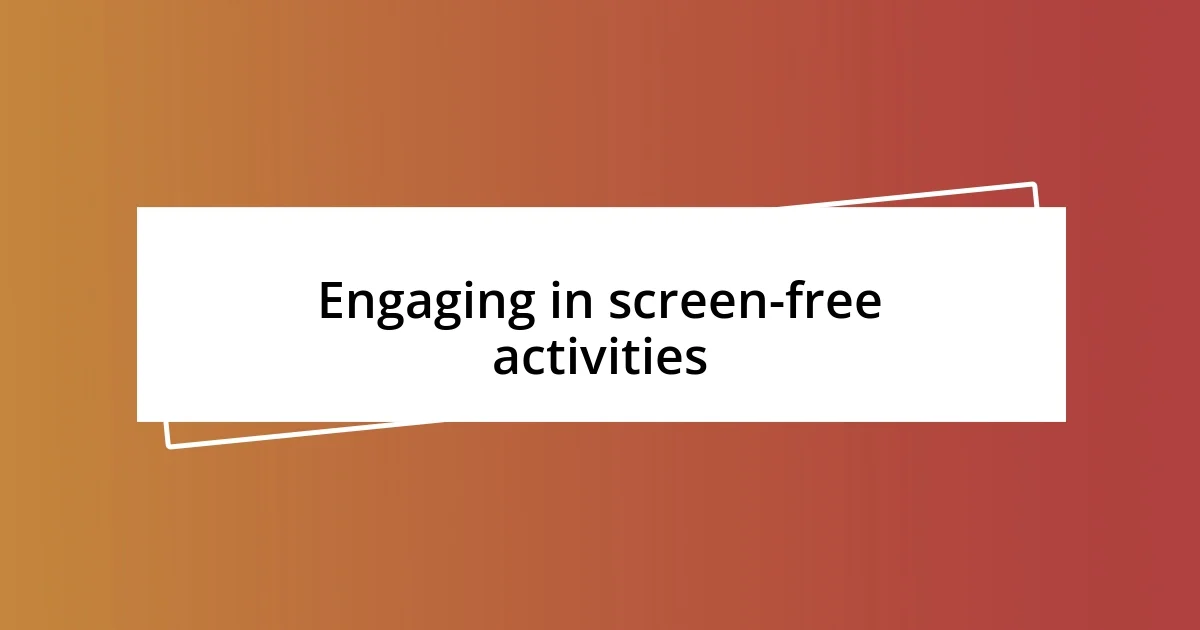
Engaging in screen-free activities
Engaging in screen-free activities has been a delightful discovery for me. I vividly remember how rejuvenating it felt the first time I dedicated an entire evening to reading instead of scrolling through my phone. Losing myself in a good book not only felt refreshing but also sparked my creativity in ways that staring at a screen never could. Have you ever felt that rush of inspiration after diving deep into a story? It’s one of those simple joys that can easily get pushed aside in our tech-driven lives.
I’ve also started incorporating nature walks into my routine, which has made a significant difference in my mood and overall wellbeing. There’s something truly grounding about stepping outside, breathing in fresh air, and just listening to the sounds around me. On one of my walks last fall, I stumbled upon a local park with beautiful autumn colors. It hit me then how much I had missed experiencing the changing seasons without the distraction of my phone. Engaging with nature has a way of reminding me to appreciate the world – something I often forget when I’m glued to my devices.
Cooking has become another screen-free haven for me. I love experimenting with new recipes, and it’s incredible how engaging my senses—from the aroma of fresh herbs to the vibrant colors of vegetables—can replace screen time in such fulfilling ways. I remember the sense of accomplishment I felt when I made my first homemade pasta from scratch. It was a mess at first, but the joy of sharing a delicious meal with loved ones made it all worthwhile. Have you ever tried stepping away from screens to whip up something new in the kitchen? You might just discover a new passion that adds flavor to your life.
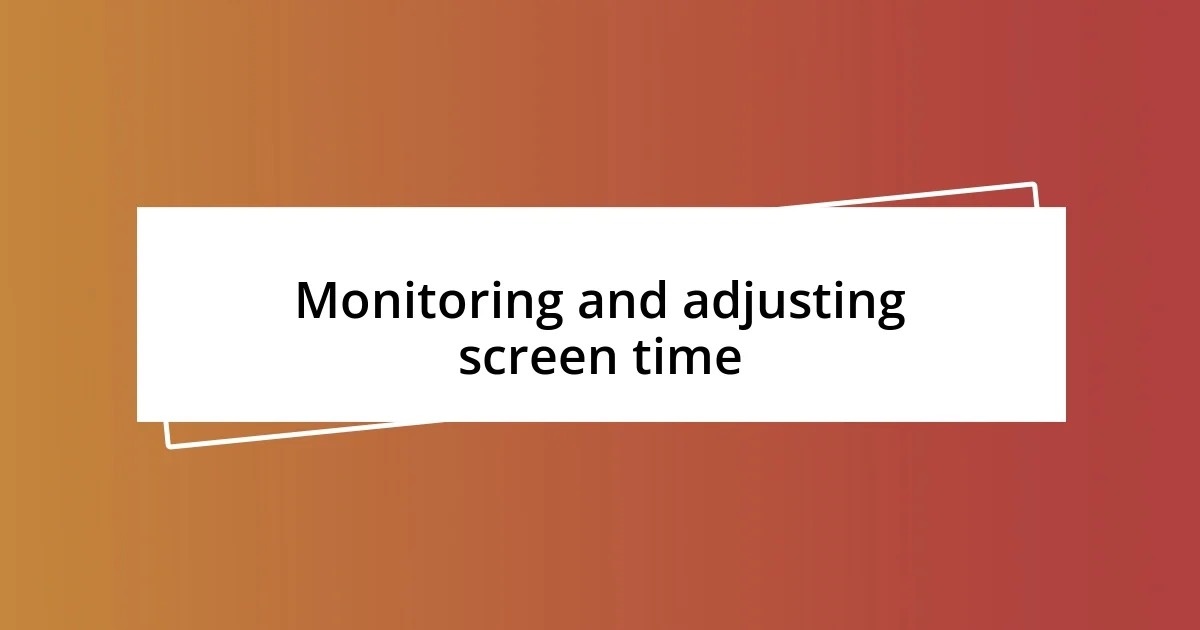
Monitoring and adjusting screen time
Monitoring my screen time has become an essential part of my daily routine. I’ve learned to use apps that track my usage, and I can’t tell you how eye-opening it is to see those numbers. There was a time when I spent about five hours a day scrolling without even realizing it! Now, I set limits for myself, and I feel a sense of control over how I engage with my devices. Have you ever checked your screen time statistics? It can be a real wake-up call.
Adjusting my screen time based on how I feel has been another game-changer. On days when I’m mentally drained, I’ve found that reducing my screen exposure helps me recharge. Last month, I felt unusually anxious and noticed I had spent far too long on social media. So, I made a conscious decision to unplug for a weekend. The relief and clarity I gained from that break were incredible! It taught me the value of listening to my body and mind—and how that awareness can shift my relationship with screens.
I’ve also started practicing regular reflection on how screens impact my mood and productivity. Journaling about my experiences has been eye-opening; I realized just how often I turn to my phone instead of tackling tasks or connecting with friends face-to-face. Just this week, I noted how much happier I felt after an afternoon spent crafting instead of scrolling through feeds. What activities truly enhance your day? Identifying those can help you make informed adjustments to your screen time.

Encouraging family discussions about screens
Encouraging family discussions about screens has been a vital step in our household. I remember the first time we sat down together and opened up about how each of us felt regarding our screen use. It was enlightening to hear my teenager express feelings of isolation, even while connected online. Have you taken the time to ask your family members how they view their own screen time? It can open doors to understanding and stronger connections.
Recently, we established a weekly family meeting dedicated to discussing our digital habits and setting new goals. What surprised me was how engaged my younger kids became when we talked about their favorite games and shows. This conversation not only helped them feel heard but also allowed us to address concerns about the balance between screen use and other activities. How often do we really engage with our loved ones about their screen experiences? This dialogue has transformed our approach entirely.
I’ve also realized the power of using relatable examples from our daily lives. One evening, I shared a story about how my own excessive phone checking led to missing out on family moments. The look on my kids’ faces when they realized that even adults struggle with this was priceless. It sparked a deeper conversation about the importance of being present. How can we hold each other accountable in a loving way? It’s those heartfelt discussions that pave the way for a more supportive family environment when it comes to screens.












